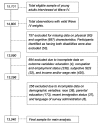Developmental disabilities and socioeconomic outcomes in young adulthood
- PMID: 25931625
- PMCID: PMC4388219
- DOI: 10.1177/003335491513000308
Developmental disabilities and socioeconomic outcomes in young adulthood
Abstract
Objective: We assessed the associations between developmental disabilities and indicators of socioeconomic outcomes (i.e., educational attainment, employment status, occupation type, subjective perception of socioeconomic status [SES], income, and wage rate) among young U.S. adults aged 24-33 years.
Methods: We used data from the National Longitudinal Study of Adolescent Health (n=13,040), a nationally representative study of U.S. adolescents in grades 7-12 during the 1994-1995 school year. Young adult outcomes (i.e., educational attainment, employment status, income, occupation, and subjective SES) were measured in Wave IV (2008 for those aged 24-33 years). Multivariate methods controlled for sociodemographic characteristics and other relevant variables.
Results: Nearly 12% of this sample presented with a physical or cognitive disability. Respondents with physical disabilities had lower educational attainment (odds ratio [OR] = 0.69, 95% confidence interval [CI] 0.57, 0.85) and ranked themselves in lower positions on the subjective SES ladder (OR=0.71, 95% CI 0.57, 0.87) than those without a physical disability. Compared with individuals without disabilities, young adults with a cognitive disability also had lower educational attainment (OR=0.41, 95% CI 0.33, 0.52) and, when employed, were less likely to have a professional/managerial occupation (OR=0.50, 95% CI 0.39, 0.64). Young adults with disabilities also earned less annually (-$10,419.05, 95% CI -$4,954.79, -$5,883.37) and hourly (-$5.38, 95% CI -$7.64, -$3.12) than their non-disabled counterparts.
Conclusion: This study highlights the importance of considering multiple developmental experiences that may contribute to learning and work achievements through the transition from adolescence to young adulthood.
Figures
References
-
- Centers for Disease Control and Prevention (US) Atlanta: Department of Health and Human Services; 2012. Key findings: trends in the prevalence of developmental disabilities in U.S. children, 1997–2008. Also available from: URL: http://www.cdc.gov/ncbddd/developmentaldisabilities/features/birthdefect... [cited 2012 Oct 8]
-
- Brault MW. Washington: Department of Commerce (US); 2008. Americans with disabilities: 2005. Current Population Reports No. P70-117.
-
- Current trends contribution of birth defects to infant mortality—United States, 1986. MMWR Morb Mortal Wkly Rep. 1989;38(37):633–5. - PubMed
-
- Centers for Disease Control and Prevention (US) National Health Interview Survey on disability. Atlanta: Department of Health and Human Services (US); 2009. Also available from: URL: http://www.cdc.gov/nchs/nhis/nhis_disability.htm [cited 2010 Nov 7]
-
- Kaye HS, LaPlante MP, Carlson D, Wenger BL. Trends in disability rates in the United States, 1970–1994. Washington: National Institute on Disability and Rehabilitation Research (US); 1996.
Publication types
MeSH terms
Grants and funding
LinkOut - more resources
Full Text Sources
Other Literature Sources
Medical


